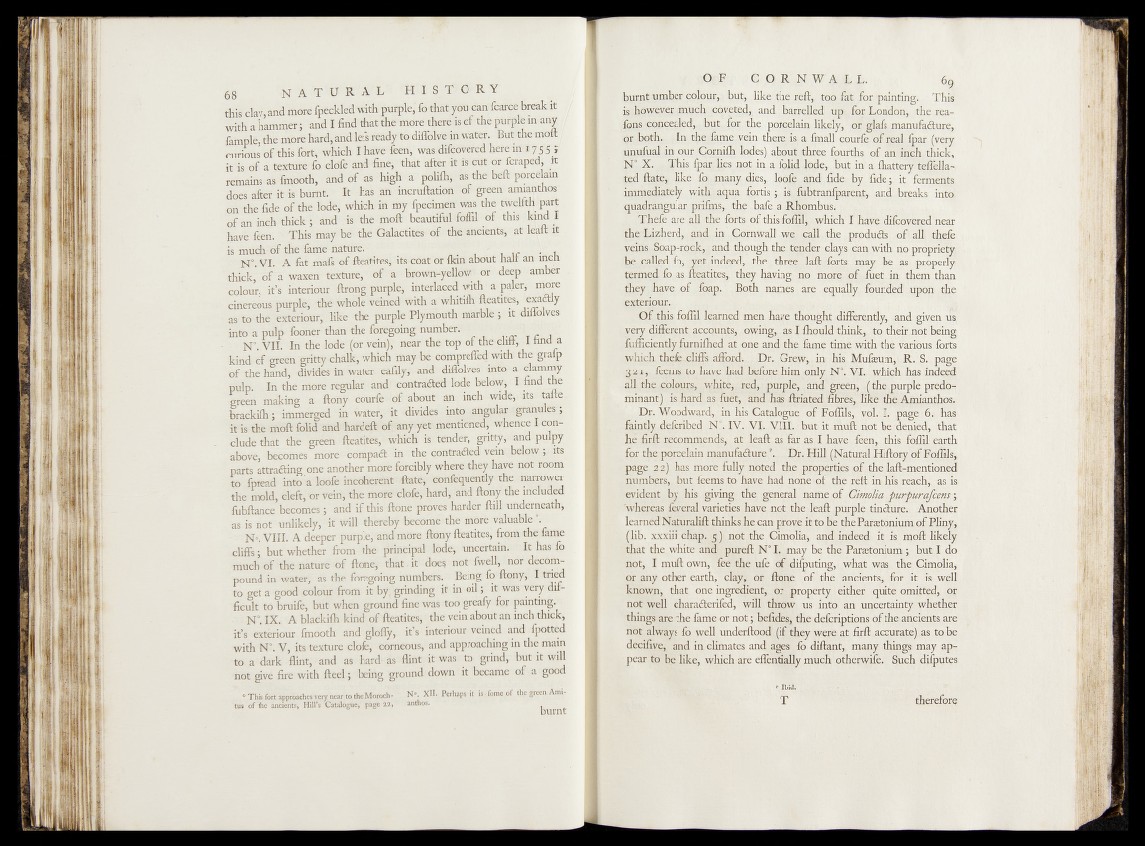
68 , T U R A L H I W T O R Y,
B H and more fpeckled'with purple; fo tha^yeii carffcaredlDre'ak'it.
with ahammer; and I find that’the'more thereis <#the purple in any j
lampfe; the more hard, and lefs ready to diffdhfe’iri water. But the molt /
curious of this fortr which Ihavefeen, was difeotered hereTiP^y 5 5 J
it is o f a texture fo dofe and fine, that after-it pth it dr fcrapdd, it
remains as fmooth, and of as high a polilh, as the-belt porcelain
does after it is-burnt.1 It -has an mcruftation of green arruajthos
on the fide of the lode, which in my fpecimen was the twelfth part
of an inch thick ; and is the mod beautiful-foffil of this fond 1
have feen. This may-'-be the Galactites-of thdancierits, f t iealt-lt
is much of the fame nature.- ’ 1 - l i§ ’ £ 1 A t f *
M l V I. A fat Tuafs of fteatites, its coat or- fkin about hall an men
: thick, 6ffa waxerr texture, of' a broWn-yelldWri or deep amber
colour, itV interiour fbong purple, interlaced with a paler, more
cinereous purple, the whole veined with a' whitiiff'fteatitfes, • 'e«a®ly
as; to- the exteriour, like -the purple Plynfouth marble; it difibkesf
into a pulp fooner than the foregoing, number.* ^ ! ‘
- N l VII. In the lode (or vein),- near the top ofthe-plitt, -1-tind-a
kind o f green gritty chalk, which may bd eompreffed with-the grafp
o f the hand, divides in water eafily, and dfflblves irif&* a clammy
pulp. In the more regular and contraded lode belbw, I find" the
gfeen making a ftony courfe of about an inch wMe,y~fe tatte
brackifh • immerged in water,- it divides into angular ^granules-;
it is the riioft folid and hardeft o f« a n y yet-mentioned, whertte feoff-
clude that the green fteatites, which i^fender, gritty^ and pulpy
above, becomes more compad in the confiraded vein below; its
parts attrading one another more forcibly where they have not room
to fpread into a loofe incoherent ftate, Gonfequemtly/the Narrower
the mold, cleft, or vein, the more clofe, hard, and ftony the included
fubftance becomes; and if this ftone proves harder ftill underneath,
as is not unlikely, it will thereby become the more valuable .
N°. VIII. A deeper purple, and more ftony fteatites, from the fame
cliffs; but whether from the principal lode, uncertain. It has fo
much of the nature of ftone, that.it does not fwell, nor decompound
.in water, as the foregoing numbers. Being fo ftony, I tried
to get a good colour from it by, grinding it in oil; it was very difficult
to bruife, but when ground fine was too greafy for painting.
N l IX. A blackifh kind of fteatites, the vein about an inch thick,
it’s exteriour fmooth and glofly, it’s interiour veined and fpotted
with N l V, its texture clofe, corneous, and approaching in the main
to a dark flint, and as hard- as flint it was to grind, but it will
not give fire with fteel; being ground down it became- of a good
0 This fort approaches very near to the Moroch- N°. XH. Perhaps it is • feme of the green Ami-
tus of the ancients, Hill’s Catalogue, page 22, anthos.
burnt
0>';F‘ ; G,- O R N W A L L. 69
burnt reft^/teq-faT fox^painting. Thil
isl^We^er.-imuch-CiCpy^ed;, a M V
icopcealed', t bpt^^^Sie porcelain likely, glafs rpapufa^tur^,
jjfffipffih«- In the fame vein /very
pnufual .in ouE^d|Ei.i^ lodes) ffioqt three, f(®rth^of Hncffthick,
^ ^ ^ ■ '^ f fhis, fpamfes^ Q t in aTp^J&le, 'but )i||a fliattei^gffplja-,
$i|d 'fta|e^ihk,e(;^fp|^nany>^es, loqfe arid udK by *hd&; it ferments
imjmg^ja.tely \\ ithjljmTji roith -j iLfubtranfp^enff aqxLbreaks intq
q u A p i i k prifms, thefimfewa Rjbmbus.
I /T}iefcïa;e,ajJ the forfs^tnis fofSfU which I nwVdifc<Arcrcd near
th^Sa^herd, andf ip , Cornwall we, cMff,tjfe femb4yg^sf.of' alh fh&fe
. veins rfeap-rq^,^ and ^pough .the tender,- dgls^an with no propriety
be^alj^d fo, qferiiq^qpd, .the, three.., fait -fate may be
termer]. fo^a| fteatites, they having^m mom^m&etcin them;tmp
they havq of |,fpap. Both name's^ am .yguafty/foupd’ect upon the
exteriour.
O f this foffrl learned men have .thought (differently, ,and.giyen u&
f$ery different accents, owing,., as fafliouldthmlff tq tMifafiot .being
f fufliciently.furnifhed at4operand the famemme with the various forts
which. riy^fecliffs afford. ^Dr^.Grew, 0 $ his Mufasqm,* R. SAnage
321, (ferny to^have had before, hipi only-Nj. VI. which has indeed
all the,tcplours, ygtoê^/red, jpurple,arid 'jgtepn, .(the^purple predoy
minant) is'nara as fuet, and has“ ftriated ffpres,*likehh^ Afai-ianthns.
Dr. W.oodward^-jnffh, .^atalog^ of FpfTff, ba4
faintly ,defcribed N). IV. VL VIII. r but ii rnuft, not be .denied, ±haf
he firft recommends, at leaft asffar a,s,I havedfeén, ..this fdffil- earth
sfetr the porcelain manufadure I Dr. HillhNatural Hihoiy,pf @)ff3s^
page 2 2)„rhas, rpord fully noted the properties of the ^.ft-mentioneq
^um{9r§,...but fems to have har] none *of^® Jeft in M reapS,.- as'is
evident by his giving the, general name of Gjmolia „purpurafeens;
'whereas feveral varieties have nqLthe leaft pyrple, tindtu^e.j Apother
learned Naturalift thinks he can-prove it to be the Parastonium.of Pliny,-
(lib. xxxiii chap. 5) not the Cimolia, ahd.jndee,d it is moff likelyr
fffiat the white and- pureft N* Ifepay he the ^aratonium; but I do
not, I muft own, fee the ufe ' ó f difputing, wh^t- W;a,%, the Gimplia,-
or any other earth, clay, or ftope. off the W©ients^.fcr i t is* well
known, that one ingredient, off property either quite omitted, or
not well charadterifed, will throw us into an uncertainty whether
things are the fame or not; befldes, the defcriptions öflt^e^apcieuts are
not always fo well underftood*., (if. they wet^ajt. firft .acqurg|p)^as to be
decifiye, and in climates and ages fo diftant, many tilings mgy appear
to be like, which are effentially much, otfieiyrife. ‘ Such difputes
p. M.
■ therefor?